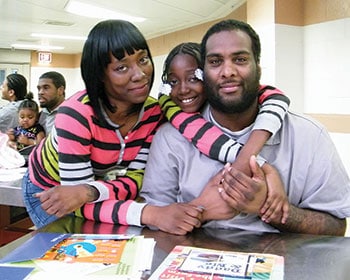
Like any librarian, Dan Marcou gets to know his patrons. He knows about their families, what they like to read, and where they’re from. He often puts aside special books he knows that they’ll enjoy. But unlike most librarians, he ultimately hopes he’ll never see them again.
Marcou is a corrections librarian with Hennepin County (Minn.) Library, and his patrons are the residents of Hennepin County Jail. He remembers the first time he saw one of his favorite patrons back in jail after being released just a few weeks earlier.
“It was this very eyeopening moment,” says Marcou. “I thought, ‘I enjoy talking with you. You’re a nice person. I’m happy to see you, but not inside the facility.’”
Marcou began to realize his job was more complex than just serving the needs of the inmates inside the jail. He needed to do more to make sure they didn’t come back. As a kid, the local library had been a respite from the institution he hated: school. What if the library could provide his patrons with a safe haven to learn and get the resources they needed to keep from coming back?
The complexity of reentry and recidivism
According to the National Institute of Justice, within the first three years of being released from a criminal justice facility, two-thirds of former inmates are rearrested. Within five years of release, three-quarters are rearrested.
Why is staying on the outside so difficult? The process of leaving prison and returning to society, often referred to as reentry, can be complicated and fraught with problems. Housing, employment, transportation, mental and physical health, and relationships are just some of the issues Marcou says his patrons face upon leaving the jail.
“Many reentry issues piggyback off one another,” says Marcou. “A person with a job is three times less likely to reoffend. But without a place to live or transportation, it’s pretty difficult to get a job, even without a criminal record.”
In addition to the practical problems of housing and work, reentry can feel lonely and stressful. When Marcou asks his patrons why they’re back, he often gets a similar answer.
“One resident said when they’re inside, they’re surrounded by positiveness. Jail was better than real life, because they had the support, a roof over their head, food,” he says. “Someone told me, ‘I don’t want to do the things that I do, but when I walk out these doors, I have nothing.’ That doesn’t justify his actions, but it demonstrates these contradictions of what people have to face.”
After some investigation, Marcou realized there were local organizations and programs to help folks reentering society, but most people about to be released didn’t know what resources were available. The library’s first step was creating a newsletter, which eventually transitioned into a pocket guide called Going Home, with information on how local institutions, including the library, could help with housing, jobs, education, and more. An area map delineating Hennepin County Library’s 41 locations, and hotlines and websites for shelters, legal resources, and addiction and self-care support, are included.
Going Home is just one aspect of Freedom Ticket, Hennepin County Library’s reentry program. To highlight what the library can offer former offenders, staff members created a 12-minute video introducing current inmates to the library’s many services and began showing it to inmates about to be released.
“Our goal wasn’t to create a lot of new things, but to promote things that already exist,” says Marcou. “If I had a quarter every time I heard, ‘I didn’t know the library offered that,’ I’d be a rich man.”
In addition, Marcou began offering job resource workshops, connecting residents to specific industries and occupations they may be interested in, as well as offering programs to inspire and motivate inmates to make a change, like creative writing workshops and author visits.
“If people look at the narrative of their lives, especially writing things down, they gain a new perspective. They’re able to put it on the page and share it with others, which they feel proud of,” says Marcou. “And it helps our community to better understand the complexity of the lives that lead to incarcerations.”
How the library can help reconnect families

One of the most complex issues the formerly incarcerated face is creating positive relationships with friends and family, especially their children. Even a single visit by a family member in a five-year sentence reduced recidivism rates by 13–25%, according to a 2011 study by the Minnesota Department of Corrections. Creating and maintaining those connections while a person is still incarcerated seems critical to successful reentry, says Brooklyn Public Library (BPL) Corrections Librarian Nick Higgins.
“A lot of people say that reentry starts the moment people enter jail,” says Higgins. “Engaging with the library and promoting family reunification—those are all part of the reentry model.”
Higgins and his staff serve 800 to 1,000 prisoners per month in five of the 10 jails on New York’s Rikers Island. In addition to providing mobile and standing library service, the staff has worked hard to create programs that connect their patrons with their families. Once a month, they run a program called Daddy and Me/Mommy and Me, which teaches parents about the impact of early literacy and allows them to record themselves reading children’s books for their young ones at home.
While Daddy and Me/Mommy and Me allows inmates to connect with their families, library staff found they had a hard time keeping in contact with those families. So in 2014 BPL started an innovative program called TeleStory, a virtual visitation space at the library where families could video chat with their incarcerated loved ones, reading books and singing songs together.
TeleStory aims to facilitate a family connection, but the visits also help connect these vulnerable families to what the library has to offer, says Higgins. A mother who recently visited BPL with her 9-year-old son and toddler daughter seemed a little tentative and unsure of what to expect. The 9-year-old wasn’t particularly interested in the video visitation, but the library itself made a big impact.
“That day also happened to be our summer reading program kickoff,” says Higgins. “We had library card signups and book giveaways and games. It was his first time experiencing what the library had to offer and it really created a relationship with this family beyond just incarceration.”
Through a grant from the Knight Foundation, TeleStory will expand to 12 libraries across New York State, making it easier for families to connect with loved ones and giving the incarcerated a better chance at a successful reentry when the time comes.
Meeting needs without creating stigma
Just the experience of going to the library and interacting with friendly, helpful librarians can be an incredibly important step for former inmates who have experienced a lot of isolation, says Marcou.
“A community can feel like a very strange place if you’re locked away for a long time,” he says. “To be able to go into an environment where [inmates are] welcomed and encouraged, where they don’t have to worry about money—that’s unbelievably positive.”
But creating a positive space for reentry can also mean anticipating the unique needs of some former inmates. That’s what Melanie Colletti, librarian at Denver Public Library (DPL), discovered when the library started its Free to Learn program in 2010 for the formerly incarcerated.
The vast majority of women in the criminal justice system are survivors of domestic abuse, both physical and sexual, according to the Correctional Association of New York. When DPL staffers discovered most of the people using the computers in the Community Technology Center were men, they realized how difficult it might be for female ex-offenders to participate in the program.
In response, Colletti helped create Women’s Open Lab, where female ex-offenders can come in to use the computers and get help from library staff in a safe, welcoming environment. Colletti says the women got assistance in finding jobs and housing, reconnecting with family via Facebook, and learning how to download books and music.
“More importantly, they shared their personal experiences at the library with the women they knew at halfway houses and at programs they attended at other agencies,” says Colletti. “This is how we became better known as a safe space that welcomes all.”
Through operating the Women’s Open Lab and educating staff on the needs of ex-offenders, the library discovered that a separate reentry program wasn’t really necessary. So while Free to Learn doesn’t formally exist anymore, the library still maintains a database of community resources for people going though reentry, and it trains staffers to know that they can help former offenders in small ways, like signing a sheet to verify for their parole officer or release program that they attended a class.
Additionally, DPL staff members now regularly visit local correctional institutions to talk to prisoners nearing their release dates about what the library can offer them. But Colletti stresses that a participant’s affirming testimonial can do more for a program than any promotional materials.
“The better marketing tool is word of mouth,” says Colletti. “And because of our initial connections with community reentry and other organizations, the word is still out there that the public library is a good place to be.”
An essential library mission

BPL’s Higgins says helping ex-offenders is part of a library’s central mission: to serve and welcome all people. And with the rise in the prison population, the numbers of ex-offenders are growing rapidly. According to the Brennan Center for Justice, the number of people with criminal records in the United States is roughly the same as those who have college degrees.
“The criminal justice system affects so many people—not just those who are incarcerated, but their families who have nothing to do with their crimes or the system,” says Higgins. “It’s a fairly destructive system, and we’re here to help all members of our community no matter where they happen to be.”
But Higgins also stresses the joy that can come from seeing the formerly incarcerated create new lives for themselves and use the library to do it.
A few months ago, he heard someone calling his name on the street. He turned around to see a man who he had gotten to know well in a literature class he taught in Brooklyn’s federal prison. “He was riding his bicycle. It was his mother’s birthday, and he was getting a cake for her,” says Higgins. “To see somebody who is outside of the four walls of that facility, not wearing his green uniform, but riding a bicycle in Brooklyn—it was so good to see. It’s a very meaningful thing.”

 MEGAN COTTRELL is a writer, blogger, and reporter in Michigan.
MEGAN COTTRELL is a writer, blogger, and reporter in Michigan.
